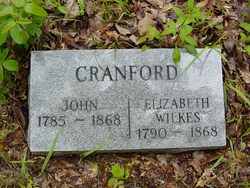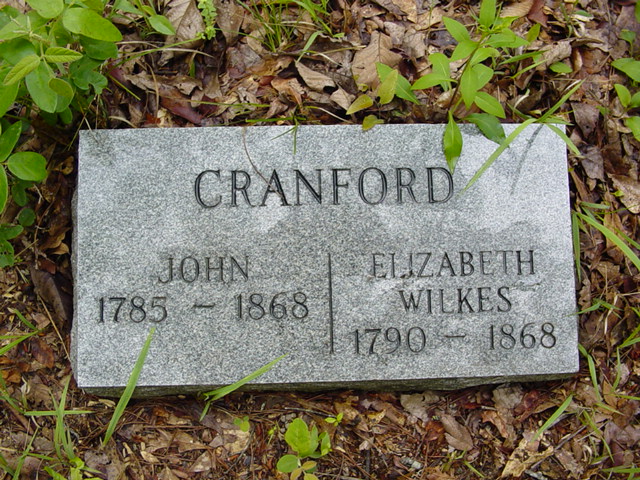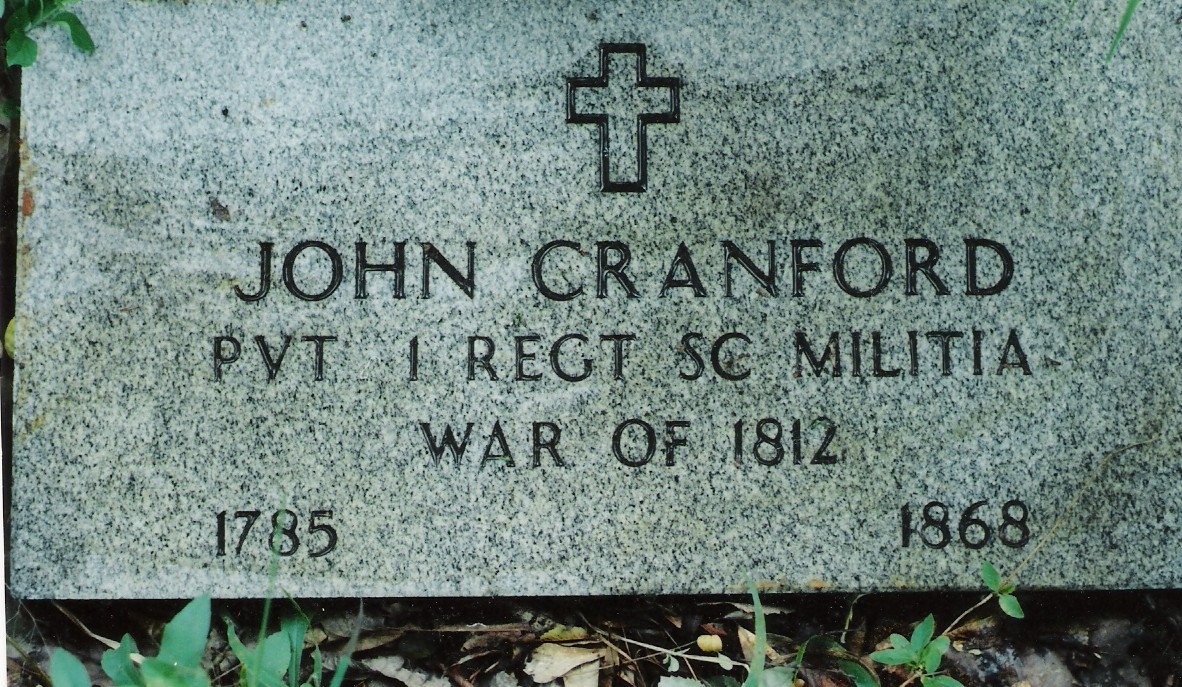PVT 1 REG South Carolina MILITIA
Son of
William Henry Cranford & Nancy Littleton
Grandson of Elias J. Cranford (b. 1720)
Husband of Elizabeth Wilkes
(daughter of
Abner Wilkes and Martha Crowder/Crider)
Father of
1. Abner Cranford
2. Winifred Cranford b. 1811
3. Mary "Polly" Cranford
4. Celia Cranford
5. Martha Patricia Cranford
6. William Cranford b. 1818
7. Thomas Matthew Cranford b. 1820
8. Charlotte Cranford
9. John Monroe Cranford
10 Malinda E. Cranford b. 1825
11 Nancy Emily Cranford b. 1827
12 Minerva "Dannie" Cranford
13 Lydia Ann Dorcas Cranford b. 1831
14 Chesley Hardy Cranford b. 1823
John Cranford, husband of Elizabeth Wilkes, died on his farm in Walker County, Alabama. He is buried beside his wife in the old Cranford Grave Yard at the foot of Cranford Hill, about one mile north of New Hope Church in Walker County. Mr. Cranford was a veteran of the War of 1812, and was at the Battle of New Orleans according to family legend. He enlisted as a private in Colonel Mean's First Regiment of South Carolina Militia on 14 October 1814 and was discharged at Charleston, South Carolina, on 7 March 1815. John Cranford's brother, Josiah, was also in the same regiment and had the same service as John. Their pay was eight dollars per month, and they were allowed two rations, valued at 18 cents each, while traveling from Charleston to their homes.
After Elizabeth Wilkes and John Cranford were married, they lived in North Carolina a short time and then moved to Chester County, South Carolina. They lived in the Baton Rouge section of Chester County until about 1822. They then moved to Morgan County, Alabama. They settled and farmed near Falkville until about 1838, when they moved to Walker County, Alabama. Here they lived for the remainder of their lives.
Information obtained from 'Wilkes Family History and Genealogy', by Ivan Ernest Bass
Their original graves were marked by field rocks
PVT 1 REG South Carolina MILITIA
Son of
William Henry Cranford & Nancy Littleton
Grandson of Elias J. Cranford (b. 1720)
Husband of Elizabeth Wilkes
(daughter of
Abner Wilkes and Martha Crowder/Crider)
Father of
1. Abner Cranford
2. Winifred Cranford b. 1811
3. Mary "Polly" Cranford
4. Celia Cranford
5. Martha Patricia Cranford
6. William Cranford b. 1818
7. Thomas Matthew Cranford b. 1820
8. Charlotte Cranford
9. John Monroe Cranford
10 Malinda E. Cranford b. 1825
11 Nancy Emily Cranford b. 1827
12 Minerva "Dannie" Cranford
13 Lydia Ann Dorcas Cranford b. 1831
14 Chesley Hardy Cranford b. 1823
John Cranford, husband of Elizabeth Wilkes, died on his farm in Walker County, Alabama. He is buried beside his wife in the old Cranford Grave Yard at the foot of Cranford Hill, about one mile north of New Hope Church in Walker County. Mr. Cranford was a veteran of the War of 1812, and was at the Battle of New Orleans according to family legend. He enlisted as a private in Colonel Mean's First Regiment of South Carolina Militia on 14 October 1814 and was discharged at Charleston, South Carolina, on 7 March 1815. John Cranford's brother, Josiah, was also in the same regiment and had the same service as John. Their pay was eight dollars per month, and they were allowed two rations, valued at 18 cents each, while traveling from Charleston to their homes.
After Elizabeth Wilkes and John Cranford were married, they lived in North Carolina a short time and then moved to Chester County, South Carolina. They lived in the Baton Rouge section of Chester County until about 1822. They then moved to Morgan County, Alabama. They settled and farmed near Falkville until about 1838, when they moved to Walker County, Alabama. Here they lived for the remainder of their lives.
Information obtained from 'Wilkes Family History and Genealogy', by Ivan Ernest Bass
Their original graves were marked by field rocks
Family Members
-
![]()
Abner Cranford
1809–1888
-
![]()
Winifred Mary Cranford Speegle
1811–1867
-
Celia Cranford Blevins
1812–1890
-
![]()
Mary Elizabeth "Polly" Cranford Stringer
1813–1895
-
Martha Patricia "Patsy" Cranford Speegle
1815–1910
-
![]()
Thomas Matthew Cranford
1817–1866
-
![]()
Charlotte Cranford Gibson
1817–1904
-
![]()
William Cranford Sr
1818–1885
-
![]()
Malinda E. Cranford Tubbs
1825–1897
-
![]()
Nancy Emily Cranford Tubbs
1827–1919
-
![]()
Minerva "Minnie" Cranford Childress
1827–1926
-
![]()
Lydia Ann D. Cranford Randolph
1831–1914
-
![]()
Chesley Hardy Cranford
1833–1911
Advertisement
Records on Ancestry
Advertisement

















